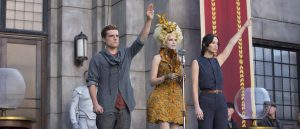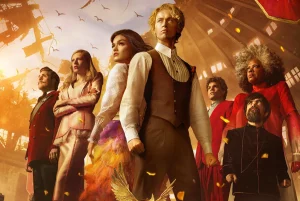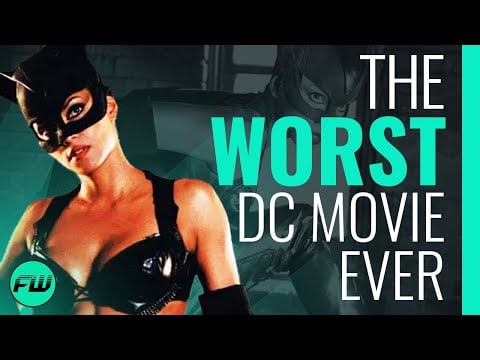The early to mid 2010s were dominated by young adult dystopian literature, a science-fiction subgenre about teenage rebels rising up against authoritarian regimes while navigating typical teenage problems, the most popular of these being The Hunger Games by Suzanne Collins. The literary trilogy set in a post-apocalyptic North America whose fascistic government forces its youth to fight to the death in an annual televised event proved to be a massive hit with readers due to its strong world-building and relatable characters. So much so that a movie adaptation was inevitable.
And from 2012 to 2015, the Hunger Games film series dominated the box office and much of pop culture as a whole; supplanting the likes of Harry Potter and Twilight as the most popular young adult franchise. Though young adult dystopia has fallen out of favor over the years due to countless Hunger Games knock-offs, it would appear that the appetite for The Hunger Games itself has not yet been satiated; with the prequel The Ballad of Songbirds and Snakes, focusing on a young President Snow and based on the 2020 novel of the same name, set to hit theaters soon.
With the new film fast approaching and the genre that it inspired largely disappearing, I’ve found myself wondering how well the Hunger Games movies hold up today. Now that the massive cultural hype machine has faded away, is there still anything left to appreciate in these four films? Well, there’s only one way to find out.
Also Read: “Tom Blyth gives the performance of a lifetime” Rachel Zegler Outshines Jennifer Lawrence As Critics Call The Hunger Games Spin Off The Best Movie In The Franchise
The Hunger Games (2012)

The first film, based of course on the first book, centers on 16-year-old Katniss Everdeen, played by Jennifer Lawrence. A lifelong resident of District 12, the poorest of the twelve districts that make up the nation of Panem, she is the primary caretaker of the family and shares a particular bond with her younger sister Primrose. When Prim is chosen as the female tribute for the 74th Hunger Games, Katniss volunteers to take her place; joining male tribute Peeta Mallark, played by Josh Hutcherson,
The two travel to Panem’s Capitol and make a spectacular impression on its citizens thanks to Katniss’ literally and figuratively fiery attitude and Peeta telling everyone that he and Katniss are star-crossed lovers. Once the Games begin, the other tributes are picked off one by one until only Katniss and Peeta remain. The two decide to eat poison berries at the same time to prevent the Capitol from having a victor, only for the Gamemakers to let them both go free; much to President Snow’s chagrin.
I was very surprised by how well The Hunger Games (2012) holds up as an individual film. Jennifer Lawrence gives a truly great performance as Katniss, character relationships and world-building are all very compelling, and the costume design in particular is immaculate, showing off each character’s individual personalities with remarkable gusto.
Where the film starts to lose me is, ironically enough, the Games themselves. The action sequences aren’t bad per se; but the restrictions of a PG-13 rating prevent the kills from having the impact they should and it’s where the film’s egregious use of shaky cam is at its worst. Plus, the otherwise quick pacing grinds to a halt during this section and the forest arena feels too similar to District 12 to be that engaging visually.
The Hunger Games: Catching Fire

Catching Fire, the second movie based on the second book, picks up shortly after the first film left off; with Katniss living in her new Victors’ Home and suffering from PTSD when both her and Peeta are sent on a Victory Tour across all the districts. Here, under President Snow’s direct orders, they must convince the citizens that the berry incident was an act of love rather than defiance; as Katniss and Peeta’s victory has become a symbol of hope for the growing rebellion against the Capitol.
Just when the two think they’re out of it, the Capitol announces that the next Hunger Games will exclusively feature previous victors in honor of the 75th anniversary and third Quarter Quell of the Games; sending Katniss and Peeta back into the arena against a veritable army of experienced killers. And the arena itself is no walk in the park either, with plenty of environmental hazards and dangerous terrain all designed to kill as many people as possible as painfully as possible.
Katniss and Peeta forge an alliance with some of the other returning tributes in an attempt to destroy the arena; but Katniss is scooped out at the last possible moment by Head Gamemaker Plutarch Heavensbee, played by the late great Phillip Seymour Hoffman. As it turns out, Plutarch is a double agent working for the rebellion and planned these Games in conjunction with the other tributes specifically to get Katniss to their base: the previously thought destroyed District 13.
Catching Fire is a textbook example of the right way to do a sequel. Take what worked about the first film, in this case the unique premise and strong character work, and expand on it. The returning tributes are all much more fleshed out characters than Katniss and Peeta’s competitors in the first film and the giant clock arena with different obstacles every hour makes for far stronger action scenes; even if the PG-13 rating still holds things back.
The world-building and political commentary is also more engaging; showing the growing tensions between the Capitol and the districts while drawing powerful parallels to real-world fascism. Plus, Jennifer Lawrence really gets to stretch her emotional range as Katniss this time around and unlike Gary Ross, now franchise-staple director Francis Lawrence doesn’t rely on shaky cam.
However, the film does have some pacing issues. Like its predecessor, it’s two and a half hours long and really doesn’t need to be, with the love triangle scenes in particular feeling dragged out and done under obligation. Moreover, the dramatic ending cliffhanger suffers from “Tell, Don’t Show” syndrome. We are told Katniss is going to District 13 and that District 12 was destroyed, but we don’t actually get to see it and therefore don’t feel the emotional impact as much.
The Hunger Games: Mockingjay – Part 1

As Mockingjay – Part 1 opens, Katniss is still reeling from the events of the Quarter Quell, the loss of District 12, and not knowing where Peeta is; initially refusing to become the public face of the rebellion due to being drained by grief. But when Katniss discovers that Peeta is in the custody of the Capitol and has seemingly been brainwashed to spout their propaganda, she agrees to become the symbolic Mockingjay in exchange for the extraction and full pardon of Peeta and the other surviving tributes.
Katniss travels to several of Panem’s districts to fight the war head-on in addition to filming promos for the rebellion and providing humanitarian aid to civilians. Eventually, the rebellion is able to rescue Peeta; but a potent mix of hallucinogens and brainwashing make him believe Katniss is a literal monster. If this plot synopsis seems shorter than all of the other ones, it’s because Mockingjay – Part 1 is the shortest entry in the franchise at only two hours and not a lot of substantial plot development happens in it.
Both this film and its successor suffer due to the decision to split the Mockingjay book into two separate films. There can’t be too much plot progression in this film because then there’d be nothing left for Part 2. Most of the film feels like exposition and set-up for the final confrontation to come in the next film; meaning what’s here feels more like a collection of scenes than a proper narrative.
Yet at the same time, said scenes are often genuinely great. The bits where Jennifer Lawrence has to pretend to be a bad actor in Katniss’ propaganda films are legitimately funny and add a welcome bit of levity to the otherwise grim proceedings. Moreover, the exploration of symbology of revolution is pertinent and powerful stuff; with the extended “Hanging Tree” sequence in particular being one of the best moments in the entire franchise.
The Hunger Games: Mockingjay – Part 2

Mockingjay – Part 2 picks up immediately after Part 1, with Katniss continuously attempting to undo Peeta’s Capitol brainwashing as the rebellion prepares for the final battle against President Snow. While Katniss eventually succeeds, they have bigger problems: Snow has evacuated the Capitol in order to rig the whole of the city with booby traps designed to kill the rebellion, effectively creating one last Hunger Games arena.
Katniss, Peeta, Gale, and the rest of the rebellion, despite several casualties, eventually make it to President Snow’s mansion after Snow appeared to bomb Capitol civilians just to keep the rebellion at bay: a move that turned even his most staunch supporters against him. However, when Katniss finds Snow, he reveals that he did not order the bombs at all, rebellion leader President Coin did.
This, combined with Coin’s controlling tendencies and her proposal of a new Hunger Games with Capitol children, convinces Katniss to shoot Coin in the chest with an arrow during an execution ceremony where she was supposed to shoot Snow. Eventually, a peaceful democracy is established and years later Katniss lives a happy life with Peeta and her two young children, ending the story.
The biggest problem with Mockingjay – Part 2 is that despite it being what we’ve been supposedly building up to this whole time, it’s honestly really boring. The action scenes, plentiful as they are, are bland and lifeless with very little going for them. Moreover, up until the ending, Katniss herself is a very static character in this story. She doesn’t get to be in the main squad for the war effort and is literally unconscious during the rebellion’s final victory, only being informed of it later.
Additionally, I find the twist with President Coin being secretly evil to be really stupid and out of nowhere; a frankly asinine method of making Snow appear more sympathetic and the politics of the world more complex than either of them actually were. There are a handful of good character moments and the ending is admittedly cathartic, but this is without a doubt the weakest entry in the series.
In Conclusion

I started this article by asking if The Hunger Games as a series still held up. And after revisiting all four films, I think the answer is yes and no. On the one hand, I don’t think any of them, even Mockingjay – Part 2, are bad movies; with the first two in particular being fairly solid and the series in general boasting a relatively unique premise and strong world-building.
On the other hand, all four entries suffer from various pacing issues, the series only barely sticks the landing by the end, the PG-13 rating means none of them live up to the potential of the premise, and while all of them are varying degrees of good, I’m not sure if any of them are truly great either aside from maybe Catching Fire.
Even as immensely positive first reactions have been flooding in for The Ballad of Songbirds and Snakes, I can’t help but wonder why we’re still doing this. Not only has the story been over for years, but we barely managed to get a solid ending the first time. Do we really want to risk muddying the waters even further with a prequel about why the fascist dictator bad guy was maybe sympathetic, actually? I haven’t seen the film yet, but for now, I stand by the idea that The Hunger Games should be left to its original time. It may have worked once, but I don’t know if the odds are in our favor for it to work again,
Follow us on Facebook, Twitter, Instagram, and YouTube for more entertainment coverage.



